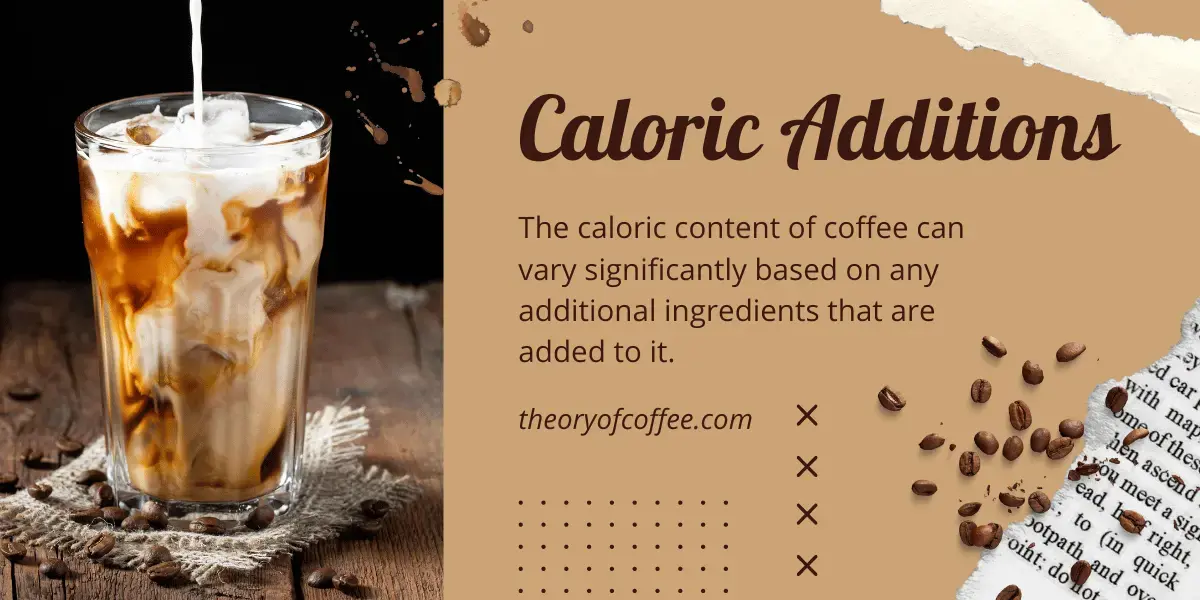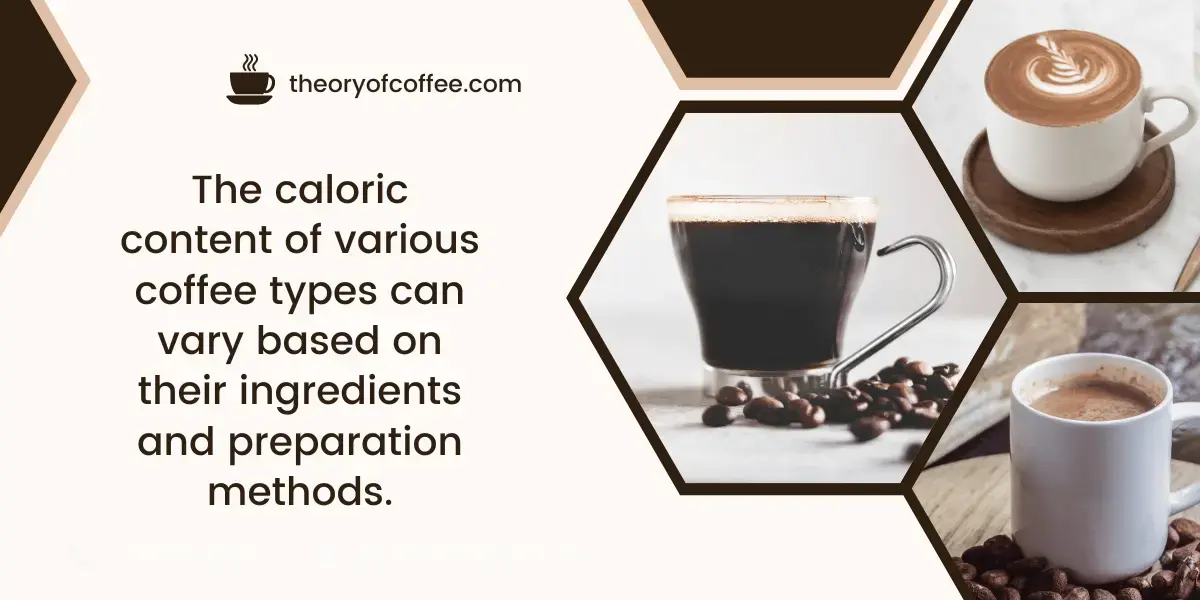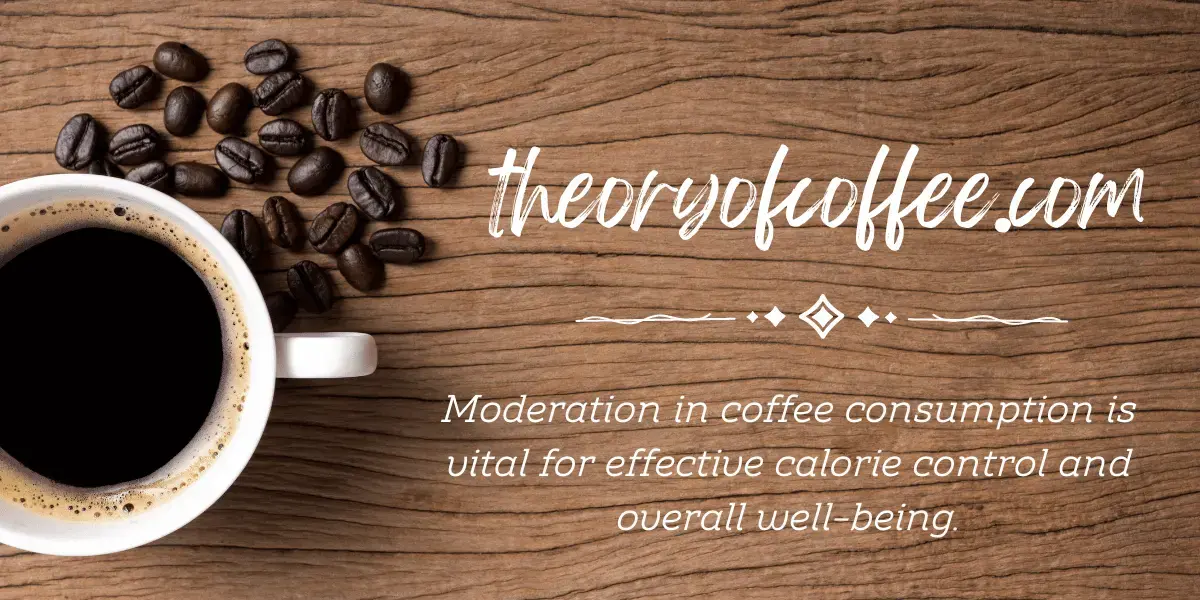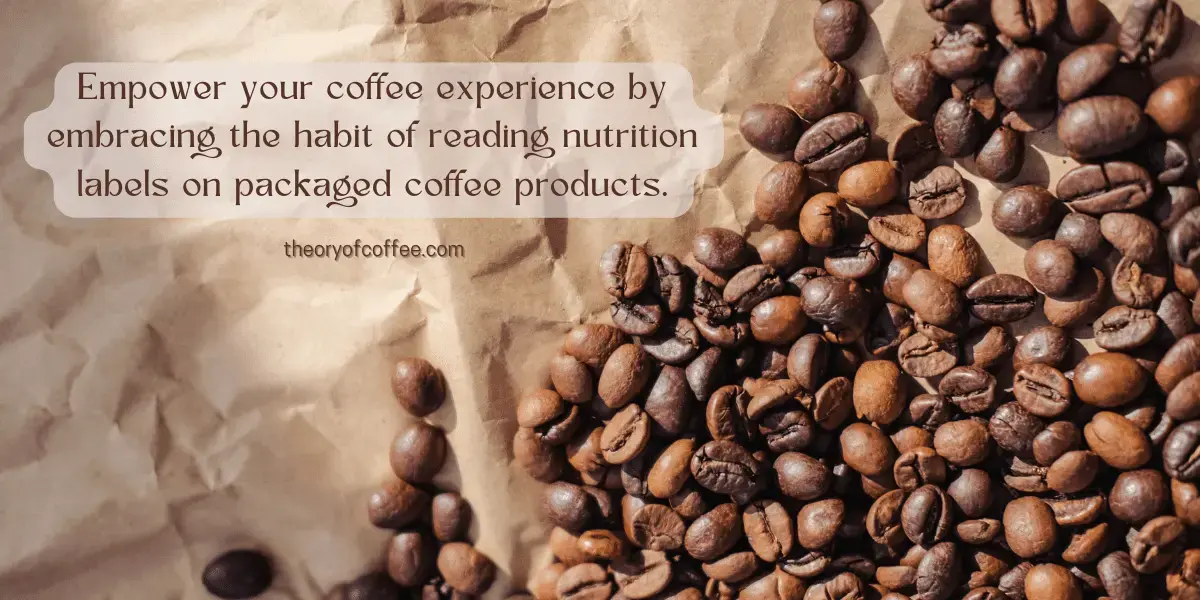The Hidden Calories in Your Morning Brew
Even simple pleasures like coffee warrant attention in a world of rising dietary awareness. Understanding the caloric content of coffee holds significant importance for individuals mindful of their dietary intake. Beyond its refreshing aroma and taste, coffee carries calories that can impact daily consumption goals. Unraveling the intricacies of coffee's caloric dimension empowers healthier choices. It highlights how a seemingly innocuous beverage can contribute to the bigger picture of nutritional well-being.
Amidst the morning routines and bustling café culture, a pervasive misconception persists the notion that coffee is calorie-free. This prevailing belief often leads individuals to overlook the potential impact of their daily brew on their overall caloric intake. This misperception underscores the critical need for accurate information. Delving into the actual caloric content of coffee sheds light on an essential aspect of nutrition, dispelling the myth and fostering a more informed approach to dietary choices.
1. Understanding the Components of Coffee Calories

Navigating the nuanced world of coffee calories entails dissecting its multifaceted components. Beyond the stimulating caffeine jolt, coffee contains various elements contributing to its caloric content. Each facet influences the final caloric tally from the beans' origin and roast level to added ingredients like milk, syrups, and sweeteners. Unraveling these components demystifies the caloric puzzle and empowers individuals to tailor their coffee choices to their dietary goals.
1.1. Basic Coffee Composition
The elemental composition of coffee is relatively simple yet fascinating. It involves two primary elements:
Water
Water acts as a solvent that extracts the compounds from coffee grounds, enabling the creation of the beverage. When hot water comes into contact with coffee grounds, it dissolves and carries away the flavorful blends, creating the coffee liquid we drink.
Coffee Grounds
Coffee grounds are the crushed beans of the coffee plant. These grounds are packed with a diverse range of compounds that contribute to the taste, aroma, and overall characteristics of the coffee. Some critical components found in coffee grounds include:
- Aromatic Oils: These oils contain volatile compounds that give coffee its distinctive aroma. They contribute to the rich, complex scent that wafts from a freshly brewed cup.
- Acids: Acids in coffee lend brightness and acidity to the flavor profile. They can range from subtle to tangy and play a role in balancing the taste.
- Sugars: Sugars present in coffee contribute to its natural sweetness. The roasting process can caramelize sugars, adding depth to the flavor.
- Bitter Compounds: Coffee contains bitter compounds, which can result from the natural components of the beans and the roasting process. These compounds contribute to the overall complexity of the flavor.
- Caffeine: Caffeine is a well-known stimulant found in coffee. It's responsible for the energy-boosting effects many people seek from their morning cup.
Understanding this elemental composition provides a foundation for appreciating the various factors influencing coffee flavor, from the type of beans used to the brewing method and even the water temperature. This delicate interplay of elements transforms simple coffee grounds and water into the diverse flavors and aromas that coffee enthusiasts enjoy.
1.2. Caloric Additions
The caloric content of coffee can vary significantly based on any additional ingredients that are added to it. Here are some common caloric additions to coffee:
- Milk or Creamer: Adding milk, cream, or non-dairy alternatives like almond or soy milk can contribute calories to your coffee. The caloric content depends on the type and quantity of milk used.
- Sweeteners: Sugar, syrups, honey, or artificial sweeteners can add calories to your coffee. The calorie count varies based on the amount of sweetener added.
- Flavor Shots and Syrups: Flavored syrups, such as vanilla, caramel, or hazelnut, can introduce flavor and calories to your coffee.
- Whipped Cream: Topping your coffee with whipped cream adds a layer of richness and calories.
- Chocolate or Cocoa: Adding chocolate or cocoa powder to your coffee, such as in a mocha, increases the caloric content.
- Spices: Spices like cinnamon or nutmeg may not contribute significant calories individually but can enhance the flavor profile of your coffee.
- Alcohol: Sometimes, people add alcohol, like whiskey or liqueurs, to coffee. Alcohol contains its caloric content.
You must be mindful of these additions if you're tracking your caloric intake. Opting for lighter alternatives like skim milk, using small amounts of natural sweeteners, or choosing sugar-free syrups can help you manage the caloric impact of your coffee while still enjoying its flavors.
2. Caloric Breakdown of Different Coffee Types

The caloric content of various coffee types can vary based on their ingredients and preparation methods. Here's a general overview of the caloric breakdown for different coffee types:
- Black Coffee (Plain Brewed Coffee): Black coffee made from ground coffee beans and water is virtually calorie-free, containing only negligible calories, usually around two per 8-ounce cup.
- Coffee with Milk or Creamer: Whole Milk - a splash of whole milk (2 tablespoons) adds about 20 calories to your coffee; Skim Milk - Skim milk contains fewer calories, around ten calories for two tablespoons; Half-and-Half - Using half-and-half (2 tablespoons) adds around 40-50 calories; Cream - Heavy cream is more calorie-dense, with approximately 52 calories for one tablespoon.
- Flavored Lattes: Latte - A standard latte made with espresso and steamed milk usually contains around 120-180 calories, depending on milk type and serving size; Flavored Latte - Flavored lattes, which include syrups for taste, can have additional calories depending on the syrup's content;
- Cappuccino: Cappuccinos, which consist of equal parts espresso, steamed milk, and milk foam, generally range from 60 to 80 calories for a small cup.
- Espresso: espresso is a concentrated coffee beverage that forces hot water through finely ground coffee beans. Due to its focused nature, espresso is relatively low in calories. A standard shot of espresso (about 1 ounce or 30 milliliters) typically contains only about 1-2 calories.
- Mocha: A mocha, which combines espresso, steamed milk, chocolate syrup, and whipped cream, can have around 250-400 calories, varying with size and ingredients.
- Iced Coffee: Black iced coffee is nearly calorie-free, but adding milk or sweeteners can increase the calorie count. An iced latte's caloric content is similar to a regular latte.
- Cold Brew: Cold brew coffee is usually low in calories due to its concentrated brewing process. An 8-ounce serving might have around 5-10 calories, but this can vary based on dilution and additives.
- Coffee with Sugar and Whipped Cream: Adding sugar and whipped cream to your coffee can significantly increase its calorie content, potentially reaching 200 or more depending on the quantities used.
Remember that these approximate values vary based on factors like portion sizes, specific ingredients, and individual preparation methods. If you're conscious of your caloric intake, it's helpful to be aware of these variations when making coffee choices.
3. Factors Influencing Coffee Calories

The caloric content of coffee can vary based on several factors. Understanding these factors helps you make informed choices about your coffee consumption. Here are the key influences on coffee calories:
3.1. Portion Size
The size of the coffee cup has a direct impact on the overall calorie count of your coffee. Here's how:
- Dilution Effect: When you make a larger cup of coffee, the same amount of coffee grounds are often used to create a larger volume of coffee. This means the compounds extracted from the coffee grounds are spread out over more liquid, resulting in a potentially milder flavor. Suppose you're using additional ingredients like milk, cream, or sweeteners. In that case, the dilution effect might lead to a less concentrated taste and, therefore, fewer calories per sip.
- Added Ingredients: Suppose one adds ingredients like milk, cream, or sugar. In such cases, the caloric impact is directly proportional to the volume of the drink. For instance, if two tablespoons of creamer are added to a small cup of coffee and the same amount is added to a larger cup, the larger cup will contain more calories from the added creamer.
- Portion Control: Smaller cups naturally limit portion sizes, which can help control your calorie intake. If you're watching your calories, opting for a smaller cup might help you enjoy your coffee while being more mindful of your overall consumption.
- Customization: Larger cups often come with more room for customization. You might add milk, sweetener, or flavorings to a giant cup, all contributing to the overall calorie count.
While the elemental composition of coffee remains consistent regardless of cup size, the dilution effect and the ability to add more ingredients in larger cups can increase the calorie count. Suppose you aim to manage your calorie intake. In that case, it's essential to consider both the size of your coffee cup and any additional ingredients you might include.
3.2. Specialty Coffees
High-calorie specialty coffee drinks are enticing beverages that combine rich ingredients, flavorings, and delightful toppings. These indulgent creations aim to offer a genuinely satisfying and occasionally extravagant coffee experience. Let's explore some examples of high-calorie specialty coffee drinks along with their typical ingredients:
- White Chocolate Mocha: Contains espresso, white chocolate syrup, milk, whipped cream. White Chocolate Mocha is a luxurious blend of espresso, creamy white chocolate syrup, and steamed milk, topped with whipped cream. White chocolate contains cocoa butter, sugar, and milk solids, contributing to the caloric content.
- Caramel Macchiato: Contains espresso, caramel syrup, milk, vanilla syrup. Caramel Macchiato is an espresso-based drink with steamed milk and a drizzle of caramel syrup. Combining caramel and vanilla syrups adds sweetness and flavor, increasing the calorie count.
- Iced Blended Frappuccino: Contains coffee or coffee-flavored base, milk or cream, sweeteners, ice, whipped cream.Iced Blended Frappuccino is a blended and icy coffee treat often featuring sweeteners, flavored syrups, and sometimes even ice cream. Toppings like whipped cream, chocolate shavings, and caramel drizzle contribute to the caloric content.
- Irish Coffee: Contains coffee, Irish whiskey, sugar, cream. Irish Coffee is a classic cocktail combining hot coffee with Irish whiskey, sugar, and a layer of cream on top. The addition of alcohol and cream elevates the calorie count.
- Coconut Mocha Latte: Contains espresso, chocolate syrup, coconut milk, whipped cream. Coconut Mocha Latte is a tropical twist on a mocha featuring chocolate syrup and creamy coconut milk. Coconut milk, while dairy-free, contains natural fats that contribute to calories.
- Butter Coffee (Bulletproof Coffee): Contains coffee, grass-fed butter, medium-chain triglyceride (MCT) oil. Butter Coffee (Bulletproof Coffee) is a high-fat coffee beverage blending brewed coffee with unsalted butter and MCT oil. While it's consumed for its potential health benefits, it's also calorie-dense due to the fats.
- Café Vienna: Contains espresso, chocolate syrup, whipped cream, chocolate shavings.Café Vienna is a dessert-like coffee drink with chocolate syrup, topped with whipped cream and chocolate shavings, resulting in a higher calorie content.
Due to their calorie content, these high-calorie specialty coffee drinks are often enjoyed as occasional treats rather than daily beverages. When ordering such drinks, it's beneficial to be aware of the ingredients and portion sizes and to consider their contribution to your overall caloric intake.
3.3. DIY vs. Coffee Shops
The caloric content of your coffee can differ significantly depending on whether you make it at home (DIY) or purchase it from coffee shops. Here's how these two options influence coffee calories:
DIY Coffee
- Control Over Ingredients: When one brews coffee at home, they have complete control over their ingredients. This includes selecting the ideal coffee beans, milk preferences, desired sweeteners, and even flavorings. As a result, individuals can make mindful decisions that directly impact the overall calorie content.
- Portion Control: You can measure and control the amount of coffee grounds, milk, cream, and other ingredients, helping you manage portion sizes and calories.
- Simplicity: Preparing simple black coffee at home usually contains minimal calories, as it consists of brewed coffee and water.
- Additive Choices: Opting for healthier or lower-calorie alternatives like skim milk, sugar-free sweeteners, or natural flavorings can help you control calories.
Coffee Shops
Coffee shops offer a wide range of coffee types and specialty drinks, some of which might have higher calorie contents due to added ingredients and flavorings.
- Standardization Coffee shop recipes might include specific ingredient amounts, leading to less control over the final calorie count.
- Complex Drinks Specialty coffee drinks at cafes, such as lattes, cappuccinos, and blended beverages, often contain more ingredients that can contribute to higher calorie counts.
- Portion Sizes Coffee shop sizes can vary, and larger sizes typically contain more calories, mainly if additional ingredients are used.
- Professional Preparation Coffee shop baristas might use techniques that result in different extraction and flavor profiles, but these might not significantly impact calories.
Tips
- When making coffee at home, be mindful of ingredient quantities and use nutritional information if available.
- At coffee shops, inquire about nutritional information or choose smaller sizes to manage calorie intake.
- Consider making DIY versions of specialty drinks using lighter ingredients.
Ultimately, both options offer their advantages. Making coffee at home allows for precise ingredient control, while coffee shops provide convenience and a wide array of flavors. Being aware of ingredients and portion sizes can help you enjoy your coffee without unintentionally consuming excess calories.
4. Impact of Coffee Calories on Health and Weight Management

The impact of coffee calories on health and weight management is noteworthy, as it hinges on choices ranging from nutrient density to portion control. While black coffee is low in calories and can provide minor metabolic benefits, high-calorie coffee drinks laden with sugars and fats can contribute to weight gain and blood sugar fluctuations. Balancing coffee consumption, choosing lighter options, and being aware of hidden calories can support health goals and effective weight management strategies.
4.1. Moderation
Moderation in coffee consumption is vital for effective calorie control and overall well-being. While coffee is a low-calorie beverage, your choices regarding serving sizes, added ingredients, and frequency of consumption can significantly impact your daily caloric intake. Specialty coffee drinks, often enjoyed for their rich flavors, can harbor hidden calories from sugars, syrups, and creams. Practicing moderation ensures that these indulgent treats remain occasional rather than habitual.
Moderation helps prevent the cumulative effect of excessive calorie consumption from high-calorie coffee beverages, which can lead to weight gain and disrupt blood sugar levels. It also encourages a balanced approach to nutrition, allowing room for nutrient-dense foods that your body requires for optimal functioning. You can enjoy coffee without compromising your calorie control goals by being mindful of portion sizes, choosing lighter options when possible, and reserving decadent coffee treats for special occasions. Ultimately, moderation empowers you to strike a harmonious balance between savoring the flavors you love and maintaining a healthy lifestyle.
4.2. Dietary Goals
Coffee calories can be integrated into various dietary goals, provided they are approached mindfully and aligned with overall nutritional strategies. Here's how coffee calories can fit into different dietary objectives:
Weight Loss
- Black Coffee: Plain black coffee is virtually calorie-free and can be an excellent addition to a weight loss plan. It provides a boost of energy without adding significant calories, making it a suitable choice for those aiming to reduce their overall caloric intake.
- Caloric Awareness: For weight loss, it's essential to be mindful of additives like cream, sugar, and syrups that can quickly increase coffee's calorie content. Opt for non-fat milk or sugar-free options to control calorie intake.
- Satiety: Black coffee's appetite-suppressing effects can help curb hunger and reduce the urge to snack between meals.
Weight Maintenance
- Moderation: Maintaining weight often involves keeping a balance between calories consumed and calories expended. While enjoying coffee, being mindful of portion sizes and choosing lighter options can contribute to maintaining calorie equilibrium.
- Occasional Indulgence: If you have a favorite high-calorie coffee drink, treating yourself occasionally can be a part of weight maintenance. Ensure it doesn't become a daily habit that disrupts your caloric balance.
Muscle Gain (Bulking)
- Caloric Surplus: For those aiming to build muscle, a caloric surplus is often required. Adding calories to coffee can be beneficial in meeting increased caloric needs.
- Healthy Additions: Consider incorporating nutrient-dense additives like whole milk, Greek yogurt, or protein powder into your coffee to provide extra calories while delivering protein for muscle recovery and growth.
General Wellness
- Nutrient-Dense Options: Choosing nutrient-dense additions like unsweetened almond milk, a sprinkle of cinnamon, or a touch of natural sweeteners can enhance the nutritional value of your coffee without significantly increasing calories.
- Balanced Approach: Regardless of specific goals, maintaining a balanced overall diet is vital. Coffee should complement your broader dietary choices and not overshadow essential nutrients from other foods.
In all cases, awareness and conscious decision-making are crucial. By understanding the calorie content of your coffee and considering how it fits into your daily caloric intake, you can tailor your coffee consumption to support your unique dietary objectives. Coffee can be enjoyed with a well-rounded and thoughtful nutritional plan for weight loss, maintenance, or muscle gain.
4.3. Health Considerations
Excessive calorie intake from coffee, especially high-calorie specialty drinks, can negatively impact health, with a notable effect on blood sugar levels. Here's how:
- Weight Gain and Obesity: Excessive consumption of calorie-dense coffee beverages can result in weight gain and the development of obesity over an extended period. This additional weight raises the likelihood of experiencing various health complications, including heart disease, diabetes, and joint issues.
- Blood Sugar Fluctuations: High-calorie coffee drinks containing added sugars or syrups can prompt rapid spikes in blood sugar levels. These sudden surges are then followed by abrupt drops, resulting in sensations of fatigue, irritability, and heightened appetite. Regularly consuming such beverages can contribute to insulin resistance and heighten the risk of developing type 2 diabetes.
- Insulin Resistance: Consuming sugary coffee drinks regularly can result in a condition called insulin resistance, wherein cells become less responsive to insulin signaling. This condition is a precursor to type 2 diabetes and has significant implications for overall health.
- Cardiovascular Health: High levels of added sugars in diets, commonly found in sweet coffee beverages, can elevate the risk of developing cardiovascular diseases. This includes conditions like high blood pressure, heart disease, and stroke.
- Dental Health: Sugary coffee drinks can promote tooth decay and cavities, impacting oral health.
- Lack of Nutrient Density: High-calorie coffee drinks can often lead to a deficiency in essential nutrients as they displace nutrient-dense foods in one's diet. This displacement may result in inadequate vitamins, minerals, and fiber.
- Unintended Weight Management Challenges: Excessive calorie intake from coffee can hinder weight management, as liquid calories provide a different feeling of fullness than solid foods. This can lead to overconsumption of calories throughout the day.
- Mood and Energy Fluctuations: Blood sugar spikes and crashes caused by high-calorie coffee drinks can impact mood and energy levels, leading to irritability and tiredness.
- Habitual Behavior: Regularly consuming high-calorie coffee drinks can establish a habit of choosing calorie-laden refresh options, potentially leading to further dietary challenges.
To mitigate these negative impacts, it's advisable to select coffee options that are low in added sugars and calories. Opt for black coffee, unsweetened milk, and natural flavorings when possible. Moderation and mindful consumption are vital to enjoying coffee without compromising health.
5. Making Informed Choices

Making informed choices about coffee calories involves understanding the caloric impact of various coffee types and additives, acknowledging the significance of portion sizes, and aligning coffee consumption with individual dietary goals. By being aware of hidden calories in specialty drinks, opting for lower-calorie alternatives when available, and moderating the frequency of high-calorie indulgences, individuals can savor the pleasures of coffee while maintaining control over their overall caloric intake and promoting a balanced approach to health and wellness.
5.1. Reading Labels
Empower your coffee experience by embracing the habit of reading nutrition labels on packaged coffee products. These labels provide valuable insights into caloric content, serving sizes, and nutritional components, helping you make informed choices that align with your dietary goals. Whether you're seeking a low-calorie option or looking to balance macronutrients, deciphering nutrition labels equips you with the knowledge to craft a coffee routine that supports your wellness journey. Embrace this practice to ensure your daily brew contributes positively to your overall health and dietary aspirations.
5.2. Customization
When customizing your coffee with additives, ensure your choices are conscious and aligned with your health goals. Opt for low-calorie options like skim milk or non-dairy alternatives. Use natural sweeteners or sugar-free syrups in moderation. Be mindful of portion sizes, as excessive creamers, sugars, or syrups can quickly elevate the calorie content. Consider the cumulative effect of these choices throughout the day, and remember that balanced nutrition involves making trade-offs. Experiment with different combinations to find the right balance of flavor and health. Ultimately, by approaching coffee customization thoughtfully, you can savor your favorite brew while making choices that contribute positively to your overall well-being.
5.3. Alternatives
Here are some lower-calorie alternatives for sweeteners and creamers that you can consider using in your coffee:
Sweeteners
- Stevia: A natural sweetener with zero calories, derived from the stevia plant leaves. It's much sweeter than sugar, so a tiny amount goes a long way.
- Erythritol: A sugar alcohol with very few calories and a taste similar to sugar. It's commonly used as a sugar substitute in beverages.
- Monk Fruit Extract: Derived from monk fruit, this sweetener has no calories and doesn't raise blood sugar levels. It has a mild, slightly fruity taste.
- Agave Nectar: Agave nectar, although not calorie-free, is sweeter than sugar. This allows for the usage of lesser quantities. Additionally, it possesses a lower glycemic index.
- Honey: While honey is slightly higher in calories, it offers natural sweetness and potential health benefits. Use it sparingly for its distinct flavor.
Creamer Alternatives
- Skim Milk: Skim or non-fat milk is lower in calories and fat than whole milk or cream. It still adds creaminess to your coffee.
- Almond Milk: Unsweetened almond milk has gained popularity as a dairy-free alternative with fewer calories compared to regular milk. This versatile option offers various flavors, such as vanilla and chocolate.
- Coconut Milk: Unsweetened coconut milk is another dairy-free choice that adds a tropical twist to your coffee while keeping calories in check.
- Oat Milk: Oat milk is creamy and has a natural sweetness. Look for unsweetened versions to keep calories low.
- Half-and-Half: For a smoother, creamier texture, opt for a smaller amount of half-and-half. It contains fewer calories compared to heavy cream.
Remember to read labels to ensure you choose unsweetened or sugar-free versions of these alternatives. Taste preferences vary, so you should experiment with a few options to find what suits your palate best.
6. Conclusion

In pursuing a healthier lifestyle, understanding the caloric content of our beverages is essential. Its calorie count is negligible for a simple black coffee, making it an ideal choice for minimizing caloric intake. However, introducing milk, cream, sweeteners, and other flavor-enhancing elements can significantly increase the calorie count.
The key takeaway is that enjoying a cup of coffee in its simplest form won't significantly impact your caloric intake. If you're concerned about calories, consider opting for lower-calorie milk alternatives like almond or skim milk and experimenting with natural sweeteners or reducing the amount of added sugar. For those indulging in specialty coffee drinks, being mindful of portion sizes and choosing options with fewer additives can help you balance enjoyment and health-conscious choices.
When considering your coffee, remember that the calorie content is not the sole determinant of a balanced diet. Your overall health and well-being stem from a combination of dietary choices and lifestyle habits. Therefore, assessing the broader spectrum of factors that can influence your overall health impact is crucial rather than focusing solely on calories in isolation.